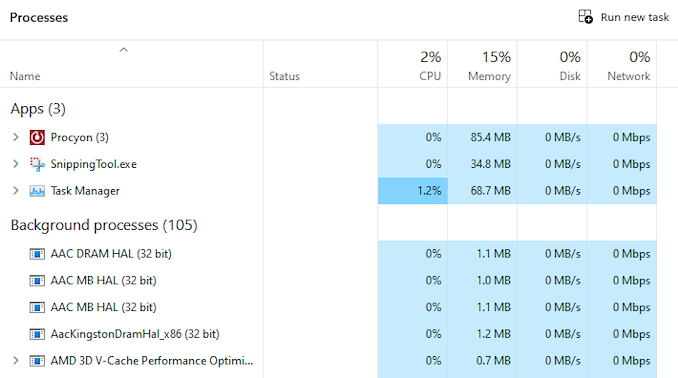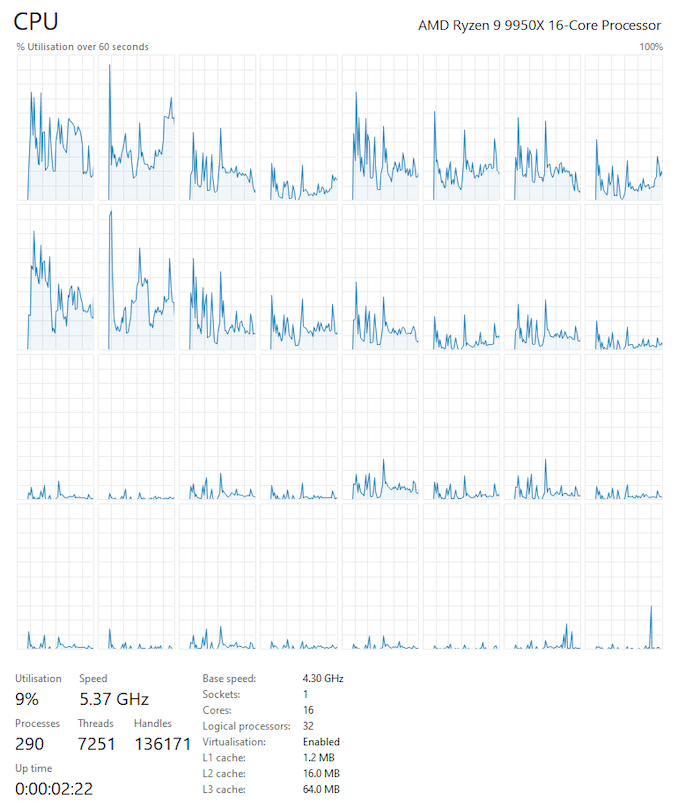Earlier this month, AMD launched the first two desktop CPUs using their latest Zen 5 microarchitecture: the Ryzen 7 9700X and the Ryzen 5 9600X. As part of the new Ryzen 9000 family, it brought their latest Zen 5 cores to the desktop market, as AMD initially launched Zen 5 through their mobile platform last month, the Ryzen AI 300 series (which we reviewed).
Today, AMD is launching the remaining two Ryzen 9000 SKUs first announced at Computex 2024, completing the current Ryzen 9000 product stack. Both chips are from the premium Ryzen 9 series, which includes the flagship Ryzen 9 9950X, boasting 16 Zen 5 cores and a boost clock up to 5.7 GHz, and the Ryzen 9 9900X with 12 Zen 5 cores and boost clock speeds up to 5.6 GHz.
Although they took slightly longer than expected to launch, there was a delay from the initial launch date of July 31st, the full quartet of Ryzen 9000 X series processors armed with the latest Zen 5 cores are now available. All of the Ryzen 9000 series processors use the same AM5 socket as the previous Ryzen 7000 (Zen 4) series, allowing users to utilize current X670E and X670 motherboards with the new chips. Unfortunately, as highlighted in our Ryzen 7 9700X and Ryzen 5 9600X review, the X870E/X870 motherboards, which were meant to launch alongside the Ryzen 9000 series, won’t be available until sometime in September.
We’ve seen how the entry-level Ryzen 5 9600X and the mid-range Ryzen 7 9700X perform against the competition, but now it’s time to see how the flagship Ryzen 9 pairing competes. The Ryzen 9 9950X (16C/32T) and the Ryzen 9 9900X (12C/24T) both have a higher TDP (170 W / 120 W respectively) than the Ryzen 7 and Ryzen 5 (65 W), but there are more cores, and Ryzen 9 is clocked faster at both base and turbo frequencies. With this in mind, let’s delve into how AMD’s Zen 5 flagship Ryzen 9 series performs with enhanced firepower, with our review of the Ryzen 9 9950X and Ryzen 9 9900 processors.
AMD Ryzen 9 9950X and 9900X:
From a product launch perspective, AMD typically introduces its Ryzen portfolio as follows: desktop processors first, then mobile chips, and usually, workstation and server parts later. However, for the launch of its latest Zen 5 microarchitecture, AMD deviated from this pattern. Last month, AMD first brought their mobile Ryzen AI 300 series to market, integrating full Zen 5 cores and compact Zen 5c cores. We did review the Ryzen AI 9 HX 370 mobile SoC, providing an early glimpse of Zen 5’s performance.
Fast-forward just over a week, and AMD released two of the four Zen 5-based desktop chips announced at Computex 2024. AMD launched the Ryzen 7 9700X, an 8C/16T chip targeting the mid-range, and the Ryzen 5 9600X, a 6C/12T variant representing the entry-level; both were reviewed. These also gave our first look at how Zen 5 compares with the previous Zen 4 architecture and Intel’s current 14th Gen Core series family.
Die shot of a Ryzen 9 (Zen 5) processor with 2 x CCDs
We have published a number of reviews and articles prior to today, including an in-depth look at the Zen 5 microarchitecture itself:
Focusing on the Ryzen 9 9950X and the Ryzen 9 9900X, apart from core count, core clock speeds, and price, the main difference between the Ryzen 9 pairing and the Ryzen 7 9700X and Ryzen 5 9600X is the number of active Core Complex Dies (CCDs) on each chip, which AMD has codenamed Eldora. For the Ryzen 9000 series, each CCD can support up to eight Zen 5 cores, with each CCD, as standard (not X3D), coming with a 32 MB pool of L3 cache. Similarly, L2 cache is held at 1MB per CPU core for the desktop chips. AMD’s latest Zen 5 core is built on TSMC’s 4nm N4P node, which is a modest step up from Zen 4. Outside of CPU cores/CCDs, AMD has opted to use the same I/O Die (IOD) as Ryzen 7000, which is manufactured on TSMC’s 6 nm node.
| AMD Ryzen 9000 Series Processors Zen 5 Microarchitecture (Granite Ridge) | |||||||
| AnandTech | Cores / Threads | Base Freq | Turbo Freq | L2 Cache | L3 Cache | TDP | MSRP |
| Ryzen 9 9950X | 16C / 32T | 4.3GHz | 5.7GHz | 16 MB | 64 MB | 170 W | $649 |
| Ryzen 9 9900X | 12C / 24T | 4.4GHz | 5.6GHz | 12 MB | 64 MB | 120 W | $499 |
| Ryzen 7 9700X | 8C / 16T | 3.8GHz | 5.5GHz | 8 MB | 32 MB | 65 W | $359 |
| Ryzen 5 9600X | 6C / 12T | 3.9GHz | 5.4GHz | 6 MB | 32 MB | 65 W | $279 |
The Ryzen 9 9950X uses two CCDs for a total of 16 cores (32 threads), with a base frequency of 4.3 GHz and a turbo frequency of up to 5.7 GHz, similar to the previous Zen 4 based Ryzen 9 7950X, which also has a max boost clock of up to 5.7 GHz. The Ryzen 9 9950X includes 64 MB of L3 cache (32 MB per CCD) with a 170 Watt TDP.
For the Ryzen 9 9900X, AMD has actually lowered the TDP down to 120 W for their 12C/24T SKU compared to the previous generation’s Ryzen 9 7900X, which had a 170 W TDP. Benefiting from Zen 5 cores, the Ryzen 9 9900X has a base frequency of 4.4 GHz and a turbo frequency of up to 5.6 GHz. The Ryzen 9 9900X also uses two CCDs on the die, giving it 64 MB (2 x 32 MB) of L3 cache.
The Return of The PPM Provisioning Driver: But There’s No 3D V-Cache, So Why?
Specifically relating to the Ryzen 9 9950X and the Ryzen 9 9900X, AMD has reintroduced their PPM Provisioning driver. The last time we saw the PPM driver was back in our Ryzen 9 7950X3D review, when AMD first introduced it alongside their first multi-CCD X3D processor. This chip was special because one (and only one) CCD came packaged with AMD’s 3D V-Cache, adding a large slice of L3 cache (64 MB) on top of the existing 32 MB of L3 cache on that CCD.
The PPM driver is a fundamental element that ensures the 3D V-Cache is fully utilized within games, which may otherwise bypass the CCD with the extra cache. It works by parking the ‘vanilla’ CCD, so that the game runs solely on the cores from the CCD with the 3D V-Cache.
For the Ryzen 7000 generation, the PPM driver was only required on the X3D chips with multiple CCDs, such as the Ryzen 9 7950X3D. But this is no longer the case, as AMD is deploying it for all multi-CCD Ryzen 9000 processors.
The AMD 3D V-Cache Performance Optimizer process running in the background (PPM provisioning)
The PPM Provisioning driver is bundled within the AMD chipset drivers (ver 6.0.6.28.910), along with the typical Promontory motherboard chipset drivers for AM5 motherboards. In tandem with Microsoft’s Game Bar and Game Mode, the PPM driver operates when Game Mode is enabled. Once a game is detected to be running, the PPM driver parks up one of the CCDs, so this essentially means when gaming, the chip is running at half capacity unless a game intentionally spins up enough threads to require the second CCD. Microsoft has a comprehensive guide to its Provisioning packages, detailing many of the benefits and scenarios where it can enhance performance. AMD leverages this feature in cooperation with Game Mode, which is enabled with the Ryzen 9 9950X and Ryzen 9 9900X.
AMD Ryzen 9 9950X in Task Manager with one CCD activated while playing Company of Heroes 3
AMD has yet to firmly document why it is using the PPM Provisioning/3D V-Cache Optimizer with non-X3D chips from the Ryzen 9000 series. We reached out to AMD for a statement, and they responded by saying that the core parking feature contains critical game processes in a single cache domain for the best gaming performance. While this is a technically accurate description of what the PPM driver does, it doesn’t clarify why multi-CCD Ryzen 9000 chips need this kind of help when the 7950X/7900X did not.
Our interpretation is that AMD encountered issues on the Ryzen 7000 series with games inadvertently straddling multiple CCDs, prompting them to use the PPM driver here as well, even with the extra complexity it entails. PPM core parking on the Ryzen 9 9950X and Ryzen 9 9900X CPUs enables AMD to more forcefully consolidate all gaming demands within a single cache domain (single CCD), which would avoid the latency-induced performance penalty of threads messaging each other from opposing CCDs or trying to access the L3 cache from outside their own local CCD.
In essence, it is the same rationale for why AMD implemented the PPM driver for the Ryzen 7000X3D chips: due to the poor die-to-die latency, having game threads spread out over multiple CCDs is detrimental to performance. Though it does suggest that the existing Ryzen 9 7900X/7950X processors may under-perform due to their loosely managed thread allocations, which might be why AMD is hesitant to discuss the issue in detail.
Another consideration is that because AMD is reusing their IOD and Infinity Fabric from the Ryzen 7000 series (only the CCDs are new), increased resource contention may have necessitated this move. In other words, while Ryzen 7000 was fine, the faster CPU cores on Ryzen 9000 are just fast enough to create a significant problem that needed addressing. Either way, the outcome for the Ryzen 9000 series is the same, but it paints Ryzen 7000 in a better light.
Game performance aside, the core parking feature also lowers the power draw and helps with thermal dissipation. So AMD will see some fringe benefits besides just keeping games from accidentally throttling by working across multiple CCDs.
| AMD AM5 Chipset Comparison | |||||
| Feature | X870E | X870 | X670E | X670 | B650E |
| CPU PCIe (PCIe) | 5.0 | 5.0 | 5.0 | 4.0 | 5.0 |
| CPU PCIe (M.2 Slots) | At Least 1 PCIe 5.0 Slot | ||||
| Total CPU PCIe Lanes | 24 | ||||
| Chipset PCIe Lanes (Max) | 4.0: 12 3.0: 8 | 4.0: 8 3.0: 4 | 4.0: 12 3.0: 8 | 4.0: 8 3.0: 4 | |
| USB4 | Mandatory (Discrete, Consumes 4 Chipset PCie 4.0 Lanes) | Optional | |||
| SATA Ports (Max) | 8 | 4 | 8 | 8 | 4 |
| DDR5 Support | Quad Channel (128-bit bus) | ||||
| Wi-Fi | Wi-Fi 7 (Discrete) | Wi-Fi 6E ( Recent PostsCategoriesGallery Scroll to Top | |||








